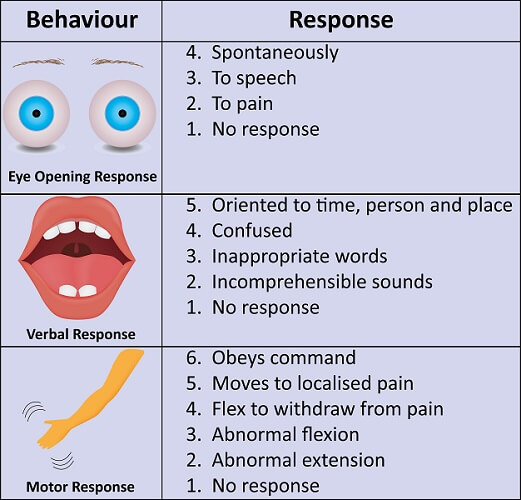The most important MODIFIABLE risk factor for CVA
Hypertension
(Smoking is second)
These are the three locations where you would see damage on MRI after a DAI.
Corpus callosum, brainstem, central white matter.
List the types of SCI (incomplete/complete, para/tetra) in order of most common to least.
Incomplete tetra
Incomplete para
Complete para
Complete tetra
These antibodies are typically tested if SLE is suspected
Anti DSDNA and Anit Sm Ab.
These are the most common primary brain tumors in children.
These are the most common primary brain tumors in adults.
Children: medulloblastoma.
Adults: glioblastoma multiforme.
This aphasia is characterized by intact fluency, impaired comprehension, and intact repetition
Transcortical Sensory
This type of TBI carries a higher risk of long-term post-traumatic epilepsy.
Penetrating head injuries.
A fracture extending from posterior to anterior through the spinous process, pedicles, and vertebral body.
Chance fracture
Most common bug involved in septic arthritis OVERALL vs in children.
Overall: S.aureus.
Children: H.influenza
These symptoms indicate a good early prognosis for MS.
Monosymptomatic, optic neuritis at onset.
A patient presents with left-sided hemiplegia and sensory loss, and right-sided tongue deviation. Where is the lesion?
Right medial medulla
A TBI patient opens his eyes in response to speech, is able to speak but uses inappropriate words, and flexes to withdraw from pain. What is his GCS score?
10

Loss of motor, pain and temperature, pinprick, with SPARING of light touch and proprioception.
Anterior cord syndrome.
This triad of signs/symptoms is typically seen in Felty Syndrome.
RA
Splenomegaly
Leukopenia
7
If hand motor recovery occurs by this time following a CVA, it is considered a good prognostic indicator.
<4 weeks.
These durations of post-traumatic amnesia and post-traumatic coma indicate poor prognosis.
PTA >3 months
Coma >4 weeks.
This nerve provides parasympathetic control of the bladder, causing bladder contraction and emptying by stimulating these receptors.
Pelvic nerve (S2-S4)
Cholinergic receptors.
This is characterized by ossification of the anterolateral spinal structures over >3 consecutive levels, sparing the intervertebral discs. In the C-spine it can compress the esophagus.
This is the normal rate of decrease of FEV1 each year.
In smokers, it can be 2-3x this amount.
This rehab method emphasizes using synergistic patterns rather than inhibiting them.
Brunnstrom
Damage to one region of the CNS produces altered function in other regions of the brain due to underlying tract connections. This is called:
Diaschisis
The level of the thoracic watershed area, where the blood supply is poor, and there is the greatest risk of ischemia (clamping of the aorta).
T4-T6 watershed area
Name the seronegative spondyloarthropathies
Ankylosing Spondylitis
Reactive Arthritis/Reiter's Syndrome
Psoriatic arthritis
Arthritis of IBD
A 30 y/o M weighs 90 kg and has severe burns over 30% of his body. How would you replete fluids?
4ml/kg body weight x% BSA --> give half over first 8 hours, and second half over next 16.
4ml x 90 = 360ml x 30 = 10.8L. Give 5.4 in first 8 hours and 5.4 in the next 16.